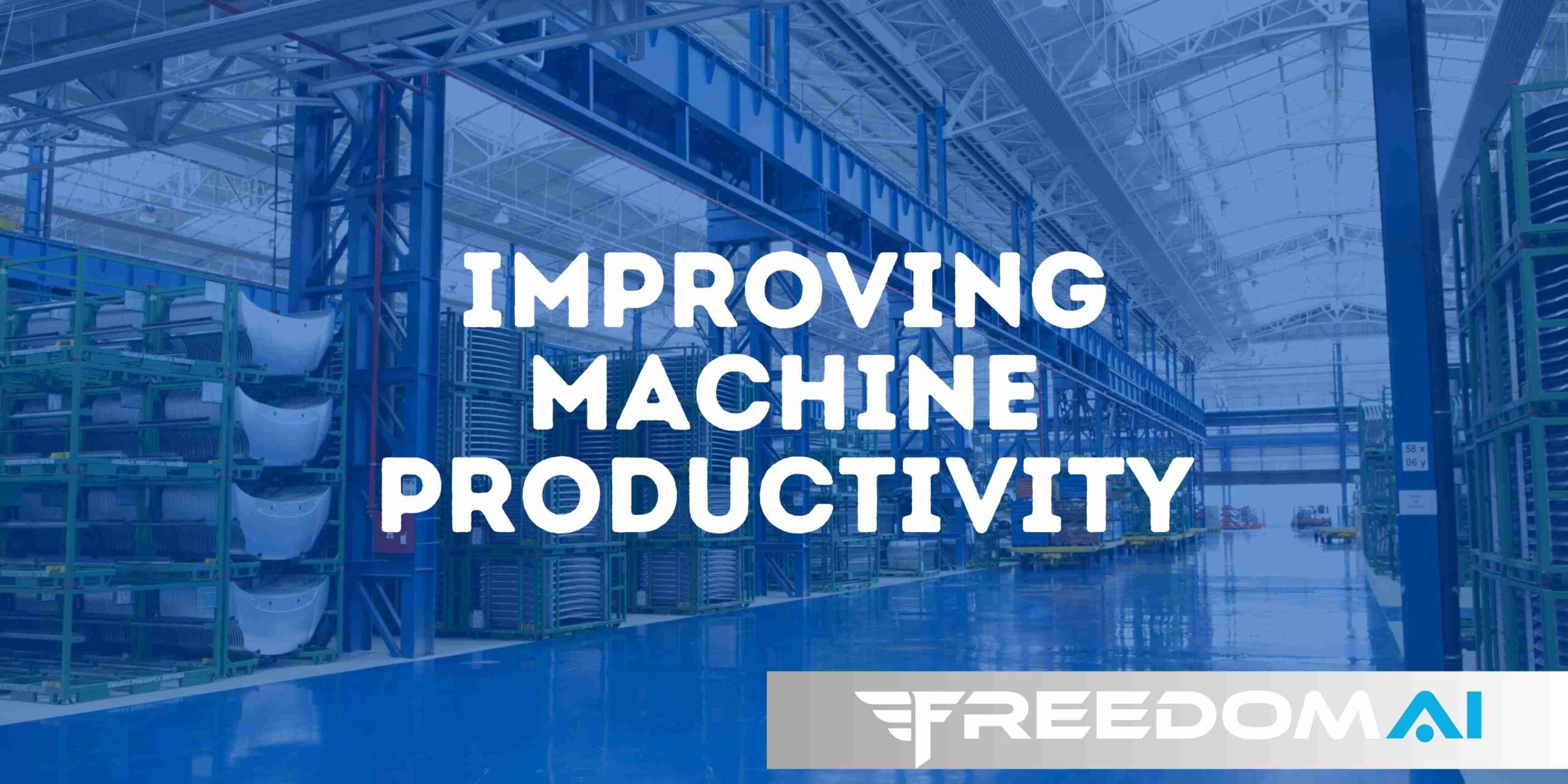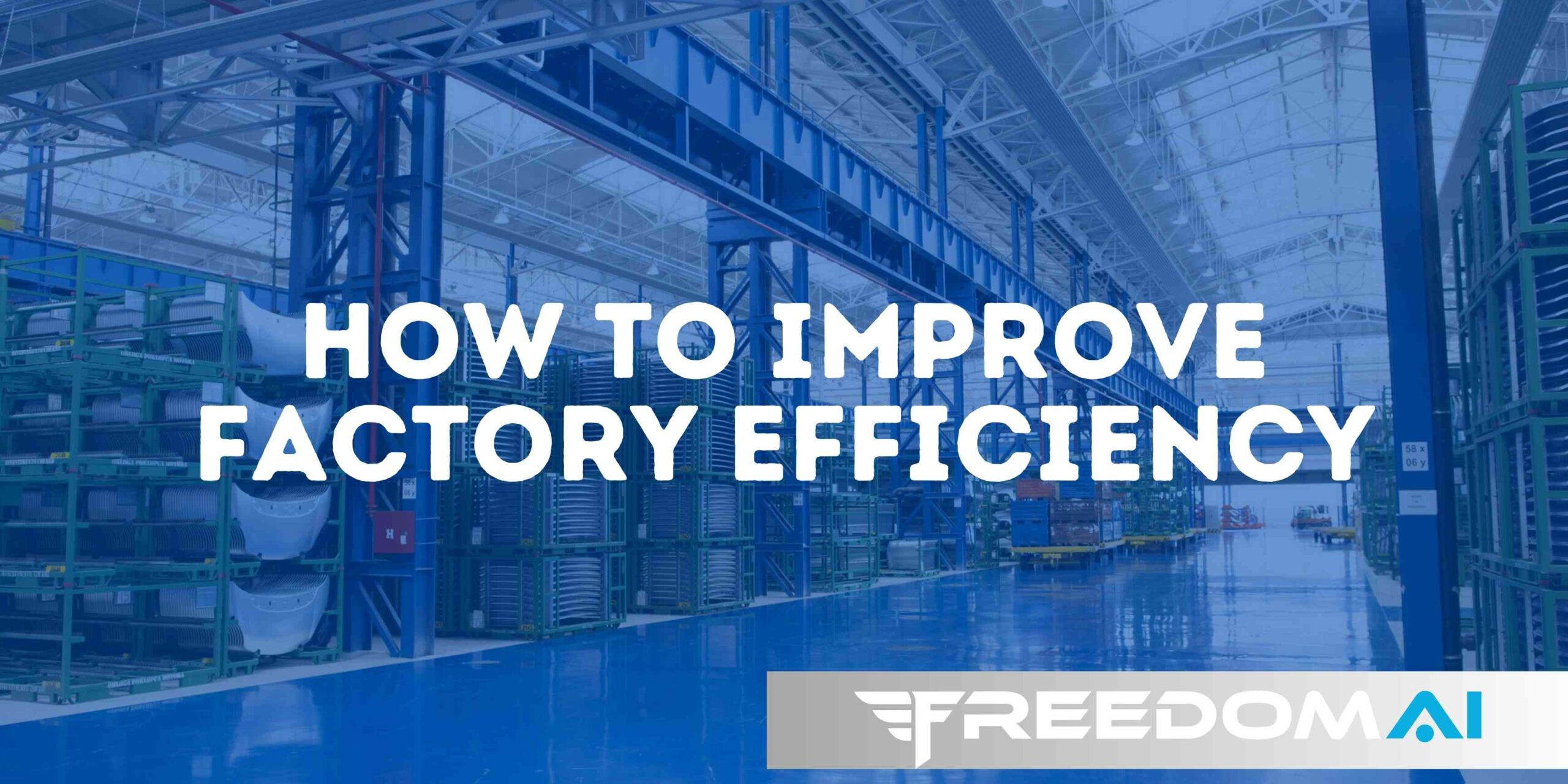Improving Machine Productivity
In the manufacturing and industrial sectors, improving machine productivity is one of the most important metrics for evaluating operational efficiency and profitability. Simply put, machine productivity measures how efficiently a machine converts input resources like labor, materials, energy etc. into desired output. The higher the productivity, the more output is generated per unit of input resource, leading to lower production costs and higher profit margins.
However, many manufacturers struggle to accurately measure and optimize the productivity of their equipment. This reduces visibility into critical production parameters and prevents them from identifying areas for improvement. Fortunately, advanced platforms like FREEDOM®AI are now enabling industrial companies to take their productivity measurement and optimization to the next level.

FREEDOM®AI provides an integrated suite of capabilities to connect, collect and combine data from machines and production lines. Powerful analytics, along with AI/ML algorithms, help generate actionable insights from the data to boost productivity. By leveraging FREEDOM®AI, manufacturers can establish an accurate baseline of their machine productivity, identify bottlenecks, reduce downtime, streamline processes, maximize output and drive profitability. The platform gives companies the digital tools to continuously improve manufacturing operations and sustain a competitive edge.
In this blog, we will dive into the what, why and how of measuring and optimizing machine productivity. Understanding these concepts is crucial for manufacturers looking to thrive in the digital age of Industry 4.0.
Understanding Machine Productivity
In the manufacturing and industrial sectors, machine productivity refers to how efficiently machinery produces goods. It measures the ratio between output (number of quality products made) and input (labor, materials, energy, etc. required). High machine productivity means getting maximum output with minimum input – like a car manufacturer producing 500 vehicles a day while using less labor, materials, and energy costs.
For example, a bottling plant has 10 machines that fill and seal bottles. If one machine fills 500 bottles per hour while using 2 workers, and another fills 800 bottles per hour with just 1 worker, the second machine is more productive. Even though both machines are doing the same task, the second one provides a higher ratio of output to input. This analogously applies to industrial equipment like lathes, presses, CNC machines, etc. Maximizing their productivity ensures optimal performance and profitability.
Fundamentally, machine productivity indicates efficiency. Comparing productivity across different assets highlights which machines operate more cost-effectively. Monitoring it over time shows improving or declining efficiency. It directly impacts the bottom line, so optimizing machine productivity is critical for manufacturers. Understanding this key performance indicator guides better asset management and operational decisions.
Machine Productivity Formula
Machine productivity is typically measured by calculating the ratio between the output generated by a machine and the input resources consumed to produce that output. The most common inputs considered in machine productivity calculations are time, materials, and labor.
The formula can be expressed as:
Machine Productivity = Output / Input
- Output = Number of quality units produced by the machine over a period of time
- Input = Resources consumed to produce the output, such as:
- Time: Total time the machine was actively operating to produce the output. This includes runtime after accounting for stops, idle time, breakdowns etc.
- Materials: Raw materials, parts, and components consumed during production.
- Labor: Total labor hours required to operate the machine and produce the output.
The output is measured in countable units produced – pieces, parts, products etc. The inputs of time, materials and labor are measured in appropriate units such as hours, kg, meters etc.
The higher the productivity ratio, the more output is being produced per unit of input resource. An increasing productivity ratio over time indicates improving efficiency in machine operation.
Various factors can affect the machine productivity formula components and the final ratio. For example, using higher quality materials can increase output per unit material consumed. Improved maintenance and faster set up can increase output per unit time. More experienced operators can increase output per unit labor. Optimizing these variables allows manufacturers to maximize productivity.
The Importance of Measuring Machine Productivity
When manufacturers start measuring their machine productivity, they quickly realize the major benefits this brings to their operations and bottom line. By tracking productivity metrics, companies gain clear visibility into the performance and output of their equipment and processes. This enables them to identify areas for improvement, implement data-driven strategies to optimize production, and increase overall efficiency.
Several key benefits arise from a focus on measuring productivity:
- Cost savings – With detailed data on machine performance, manufacturers can pinpoint and eliminate bottlenecks and inefficiencies. This directly reduces waste and drives down costs related to labor, raw materials, maintenance, downtime, and more.
- Increased output – By monitoring productivity KPIs, companies can better maximize asset utilization and staff productivity. This leads to higher throughput and increased output from existing machinery and labor.
- Enhanced efficiency – Tracking productivity reveals opportunities to streamline processes, prevent unplanned downtime, reduce changeover times, and improve overall equipment effectiveness. Greater efficiency directly translates into higher productivity.
- Informed decision-making – Comprehensive productivity metrics enable fact-based decisions about asset purchases, maintenance plans, production scheduling, layout, labor allocation and more.
- Performance benchmarking – Productivity data allows comparison across machines, shifts, lines, plants, and time periods. This internal and external benchmarking helps set targets.
The return on investment from measuring productivity can be immense. With optimization driven by data, manufacturers often experience a 10-30% boost in productivity and output. The impact on the bottom line and profit margins is substantial, easily justifying the investment required to implement robust productivity tracking. For manufacturers seeking operational excellence, productivity measurement is an essential first step.
Taking Data Collection to the Next Level
In the digital era, automating data collection provides immense advantages over manual methods. Human errors from manual data recording can significantly impact analysis, while manual processes also waste time that could be better utilized elsewhere.
Automation is key
Automated systems like FREEDOM®AI eliminate these issues by seamlessly connecting, collecting and combining data from machines through integrated sensors and internet of things connectivity. This provides a continuous stream of accurate, real-time data that creates a digital thread connecting all parts of the manufacturing process.
With automated data collection, manufacturers gain a comprehensive overview of production metrics, asset performance and overall equipment effectiveness. FREEDOM®AI ingests data direct from machines and contextualizes it with machine learning intelligence to provide predictive, prescriptive and preventative insights. This enables optimized decision making and drives productivity gains.
Step-by-Step Plan to Optimize Equipment Productivity
Optimizing productivity requires taking a proactive and strategic approach to your manufacturing operations. Here are some practical steps you can take:
1. Conduct preventive maintenance:
Set up a schedule to regularly inspect equipment and perform maintenance procedures. This helps avoid unexpected breakdowns and downtime.
2. Implement predictive maintenance with AI:
Leverage AI-powered platforms like FREEDOM®AI to analyze data and detect anomalies in real time. The system can alert you about potential problems before they occur.
3. Review output targets:
Establish reasonable output targets that align with equipment capabilities and order volumes. Track performance daily to ensure optimal production levels are maintained.
4. Standardize processes:
Document procedures for changeovers, setups, and routine operations. This minimizes variability and makes the workflow more efficient.
5. Address bottlenecks:
Identify constraints or choke points limiting your throughput. Adding resources or upgrading equipment at bottleneck areas can significantly increase output.
6. Optimize asset utilization:
Ensure equipment capacity is fully utilized over the production schedule. Avoid overburdening some assets while leaving others idle.
7. Prioritize automation:
Automating repetitive or hazardous tasks not only improves safety but also boosts consistency and frees up employees for higher-value work.
8. Provide employee training:
Invest in training programs to improve employee skills. This empowers them to enhance processes, operate equipment confidently, and troubleshoot issues.
9. Enhance maintenance planning:
Use data analysis to optimize maintenance schedules. This increases equipment uptime and availability for production.
With real-time data insights and AI-enabled predictive capabilities, FREEDOM®AI serves as an invaluable platform for boosting equipment performance. By combining data from multiple sources, the system identifies inefficiencies and opportunities to maximize output through predictive maintenance and better asset utilization. The key is having the right information to make data-driven decisions.
Unlocking Data and Automation: The Key to Future Success
The manufacturing industry is undergoing a digital transformation, with data and automation at the forefront. By harnessing the power of data and intelligent systems, manufacturers can gain a significant competitive advantage.
Automation plays a crucial role in the industry’s digital shift. Automated systems powered by AI and machine learning algorithms can handle complex manufacturing tasks more efficiently than manual work. This frees up human workers to focus on higher-level responsibilities.
By embracing data and automation, manufacturers can increase quality control, reduce downtime, improve safety, and maximize output. Manufacturers are able to not only adapt to the digital transformation of the industry, but thrive in it. With the actionable insights unlocked, they can make smarter real-time decisions that directly impact productivity and profits.
Conclusion
In today’s highly competitive manufacturing landscape, optimizing machine productivity is crucial for companies to gain a competitive edge. As illustrated throughout this article, accurately measuring and maximizing the output of equipment is key to reducing costs, increasing efficiency, and boosting the bottom line.
Platforms like FREEDOM®AI are pivotal in facilitating this optimization by leveraging data, connectivity, and intelligent automation. By collecting accurate, real-time data from machines and using predictive analytics, FREEDOM®AI empowers manufacturers to maximize uptime, enhance maintenance, and achieve impressive ROI.
In summary, machine productivity directly impacts profitability in manufacturing. To succeed in the sector’s digital transformation, companies need to embrace data-driven platforms like FREEDOM®AI. Doing so will provide the visibility and insights required to make smarter decisions and unlock operational excellence. The future belongs to those who harness technology’s potential.





